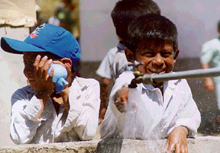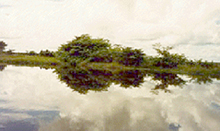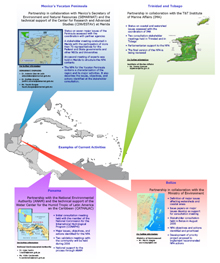International Efforts to Protect the Marine Environment from Land-based Activities
The oceans make up a global system—one that spans and impacts all reaches of Earth. Decisions we make about the use and management of our marine resources ultimately affect all individuals. Recognizing the importance of international collaboration in ocean and coastal issues, NOAA is working to build and sustain capacities for global coastal and marine stewardship through effective international partnerships.

Nearly 1.2 billion people worldwide do not have access to safe drinking water. Clean drinking water access becomes more difficult when land-based sources of pollution are introduced.
Human activities on land—in coastal areas and further inland—are threatening the health, productivity, and biodiversity of the marine environment. Land-based sources, including municipal, industrial, and agricultural wastes and run-off, account for nearly 80 percent of pollution entering the ocean. This pollution is impacting the health of the marine ecosystem and the health and well-being of the nearly one billion people globally who live in coastal urban centers. Degradation of the marine environment could threaten coastal and marine activities, such as fishing and tourism, upon which coastal populations depend.
In response to these major problems, NOAA has joined forces with the United Nations Environment Programme Global Programme of Action (UNEP/GPA) to establish a unique plan for cooperation to reduce marine pollution in the wider Caribbean region and Central America.
Background: The Global Programme of Action for the Protection of the Marine Environment from Land-based Activities
In recognition of the growing impacts of land-based activities on the marine environment, in 1995, 108 governments and the European Commission declared their commitment to protect and preserve the marine environment from the adverse environmental impacts of land-based activities by adopting the Global Programme of Action for the Protection of the Marine Environment from Land-based Activities (GPA).

Drinking water distributed by trucks to temporary water storage tanks in post-flood Guyana. Image courtesy of PAHO.
The GPA is designed to be a source of guidance to be drawn upon by national and/or regional authorities in developing national watershed management plans to prevent, reduce, and control land-based sources of pollution. One of the goals of the program is to help governments, along with a suite of stakeholders, seek their own solutions to achieving sustainable freshwater and coastal management at the national, regional, and/or local level.
The implementation of the GPA is primarily the task of individual governments, in close partnership with all stakeholders including local communities, public organizations, non-governmental organizations, and the private sector. The development of national and regional plans of action is a necessity for successful implementation. The UNEP, as the Secretariat of the GPA, and its partners are facilitating and assisting governments in their tasks.
NOAA’s Role
NOAA, with its experience and expertise in managing coastal issues, has stepped up to provide assistance to countries in developing the plans needed to adhere to the GPA. In 2004, as part of a White Water to Blue Water Conference, NOAA entered into a Memorandum of Understanding (MOU) with the UNEP/GPA. This MOU established a unique future-oriented program whereby NOAA is working with the wider Caribbean region and Central America to develop plans for protecting the marine environment from land-based activities.
NOAA and the UNEP/GPA share common goals with many in the region. These goals include catalyzing and facilitating sustained action to prevent, reduce, control, and/or eliminate degradation of the marine and coastal environments by land-based sources of pollution. The collaboration between NOAA and the UNEP/GPA recognizes the fundamental importance of management of the coastal and marine environment to ensure the sustained growth and prosperity of the wider Caribbean region.
National Programmes of Action in the Caribbean and Central America

Palm trees on a low coastal plain near the Atlantic Ocean in the “Land of Many Waters,” Guyana. Image courtesy of Guyana News and Information.
The GPA calls upon countries to develop national programmes of action (NPAs). An NPA is envisioned as an integrated management and policy framework with a comprehensive, constantly updated information base. It is not an end in itself, but is a useful strategic tool that can assist governments, industry, tourism, agricultural, or other relevant bodies and local communities prioritize development needs and goals related to coastal areas and oceans.
NPAs to protect the marine environment from land-based activities are the translation of the GPA at the national level. The implementation of the GPA and the NPAs is primarily the task of national governments. NPAs are flexible and result-oriented programs for the protection of the marine environment from land-based activities.
The aims of developing and implementing NPAs are to:
- Establish a long-term, iterative process that feeds into national development plans and priorities;
- Improve the effectiveness of existing action plans;
- Mobilize political and financial support for the long-term program and to demonstrate that land-based activities can be addressed using alternative, realistic, and country-driven approaches; and
- Raise awareness and understanding of the value, benefits, and vulnerability of strategic coastal and marine environments.
NOAA is providing technical assistance and advice to governments to help them develop their NPAs. These plans include identification of priority problems for pollution sources and effected areas. On the basis of the priorities established, governments define specific management objectives set forth in terms of overall goals, targets, and timetables. Governments are then asked to identify, evaluate, and select strategies and measures to achieve these objectives. All together, these aspects form an NPA.
In helping areas develop NPAs, NOAA has hosted or facilitated numerous country and stakeholder meetings tailored to the needs of the area concerned. Participants usually include representatives from the federal, state, and/or local governments; invited experts; research agencies; non-governmental organizations; representations from the dive industry and tourism sectors; and other stakeholders.
NOAA’s Continued Role: Progress to Date
Since becoming involved in GPA activities, NOAA has been actively working to help countries around the world in limiting pollution to the marine environment.
A Virtual Node
The four-year work plan of the MOU established a framework for collaboration on activities related to coastal and marine pollution originating from land and coastal degradation. The agreement also established a virtual GPA North American Node (NA Node) within NOAA’s National Ocean Service Staff Office for International Programs in Silver Spring, Maryland. The NA Node provides support to GPA-related activities in the wider Caribbean region at large, and this work is expanding to other select areas.
Extending the MOU
Though the initial collaboration has a timeframe of four years, expiring at the end of 2007, NOAA and the UNEP will extend this agreement for an additional four years. Both organizations look to the collaboration as part of a long-term process and solution to the marine pollution problem. Working with our partners in the regions, NOAA plans to expand in geographic scope to include the Pacific Region and Southeast Asia.
Reaching a Range of Countries

This image provides some examples of activities between NOAA and countries in the wider Caribbean. Click image for larger view.
NOAA has been working with partners in 13 countries in the wider Caribbean with plans being developed or implemented in those countries – some at national and some at regional or local scales.
At present, countries engaged with NOAA on separate NPA work include the Bahamas, Barbados, Belize, Costa Rica, Grenada, Honduras, Mexico, Panama, St. Vincent and the Grenadines, and Trinidad and Tobago. NOAA is also providing technical assistance to the UNEP Caribbean Environment Program (CEP) based in Jamaica to support NPA development in St. Lucia and Jamaica. In addition to the CEP, NOAA has partnered with many other organizations such as the UNEP's Regional Office for Latin America.
Since 2004, NOAA has received UNEP/GPA contributions and successfully competed for grants from the U.S. State Department to support implementation of GPA activities to the countries of Panama, Belize, Grenada, the Dominican Republic, Dominica, and Surinam. In 2007, NOAA’s National Ocean Service will collaborate with governments, non-governmental organizations, and private-sector stakeholders in Suriname, Grenada, Dominica, and the Dominican Republic to develop NPAs.
One of the most successful partnerships is in the Mesoamerican Barrier Reef System, where work has been conducted to assess five watersheds between Mexico, Belize, Guatemala, and Honduras. The assessment examined environmental, socioeconomic, and legal issues surrounding the watersheds. Based on the assessments, the stakeholders have been able to plan and implement integrated coastal and watershed management projects in the area.
Click here to learn more about the status of NPAs in the wider Caribbean and Latin America.
Outreach
Another aspect of NOAA's work is to disseminate information on GPA activities region-wide and to conduct education and outreach activities to promote the GPA program. Examples of NPAs are available from Trinidad and Tobago, Mexico, Panama, and Belize. NOAA has developed a range of materials related to GPA efforts, including a report on lessons learned from NPA-development experiences and a summary report on NOAA activities under the GPA MOU.
The National Ocean Service participated in the 4th World Water Forum on March 18, 2006. In October 2006, at the 2nd UNEP/GPA Intergovernmental Review Meeting (Beijing, China), governments and other stakeholders met to review the status of the implementation of the GPA and decide on action to be taken to strengthen the implementation of the GPA. At the meeting, the National Ocean Service proposed new projects for the upcoming four-year plan (2007-2010), including the implementation of a demonstration project to promote integrated coastal and watershed management in Southeast Asia and the Pacific and the completion of four additional NPAs.
Looking Ahead
NOAA’s newest plans for cooperation include developing and promoting a method where countries help other countries in NPA development by the creation of an “on-the-ground network of NPA practitioners.” In the next four years, NOAA and partners will development a “best practices” manual for NPA development, implement pilot demonstration projects promoting integrated coastal and watershed management to address land-based sources of pollution in Southeast Asia and the Pacific, and complete four additional NPAs in the wider Caribbean.
Local and national solutions implemented by nations with stakeholder participation are one of the answers to lasting improvements to the marine environment from land-based sources of marine pollution.
